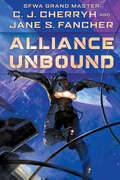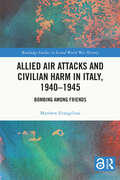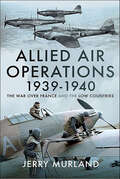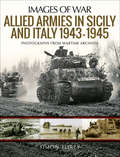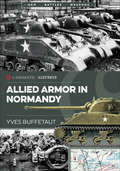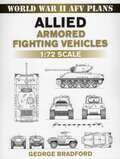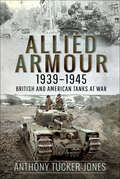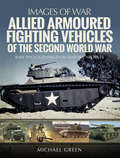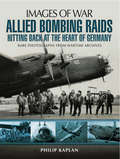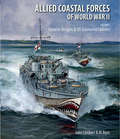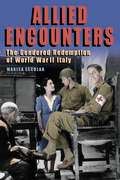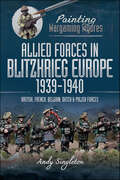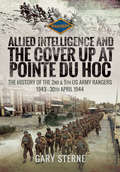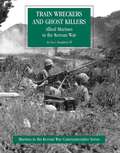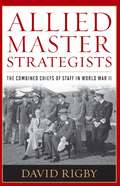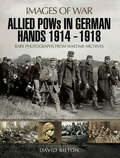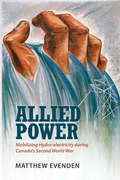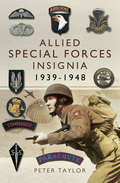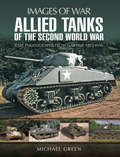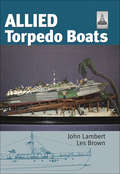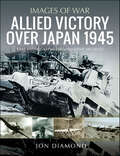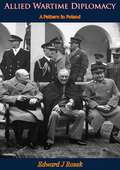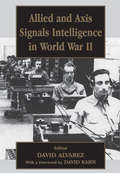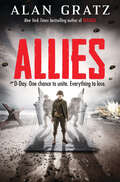- Table View
- List View
Alliance Unbound (The Hinder Stars #2)
by C. J. Cherryh Jane S. FancherThe 2nd novel of The Hinder Stars series returns to an intergalactic corporate conflict, set in the Hugo Award–winning Alliance-Union Universe.With deft prose and complex characters, Alliance Unbound is thought-provoking science fiction that shrewdly examines the technological and sociopolitical challenges of humanity&’s journey to the stars.When Cyteen opened up faster-than-light travel, it gave the technology for free to any ship that could reach it; and with that technology, it provided a map of jump-points, points of mass enabling starships to navigate hyperspace safely.The map of jump-points, however, stopped with the route to Alpha—thus excluding Sol, and Earth, and the Earth Company, whose gateway to the stars was Alpha. Cyteen knew exactly what it was doing with its gift. Sol and the EC could still reach Alpha with sub-light pusher-ships as it always had—but Sol and the Earth Company no longer had any authority in the Beyond.But Sol intends to take back control of its star-stations and stop Cyteen's unbridled expansion, however it can. To do that, they are willing to starve Alpha and concentrate their efforts on a huge FTLer capable of carrying military force.
Allied Air Attacks and Civilian Harm in Italy, 1940–1945: Bombing among Friends (Routledge Studies in Second World War History)
by Matthew EvangelistaTens of thousands of Italian civilians perished in the Allied bombing raids of World War II. More of them died after the Armistice of September 1943 than before, when the air attacks were intended to induce Italy’s surrender. Allied Air Attacks and Civilian Harm in Italy, 1940–1945 addresses this seeming paradox, by examining the views of Allied political and military leaders, Allied air crews, and Italians on the ground. It tells the stories of a little-known diplomat (Myron Charles Taylor), military strategist (Solly Zuckerman), resistance fighter (Aldo Quaranta), and peace activist (Vera Brittain) – architects and opponents of the bombing strategies. It describes the fate of ordinary civilians, drawing on a wealth of local and digital archival sources, memoir accounts, novels, and films, including Joseph Heller’s Catch-22 and John Huston’s The Battle of San Pietro. The book will be of interest to readers concerned about the ethical, legal, and human dimensions of bombing and its effects on civilians, to students of military strategy and Italian history, and to World War II buffs. They will benefit from a people-focused history that draws on a range of eclectic and rarely used sources in English and Italian.
Allied Air Attacks and Civilian Harm in Italy, 1940–1945: Bombing among Friends (Routledge Studies in Second World War History)
by Matthew EvangelistaTens of thousands of Italian civilians perished in the Allied bombing raids of World War II. More of them died after the Armistice of September 1943 than before, when the air attacks were intended to induce Italy’s surrender.Allied Air Attacks and Civilian Harm in Italy, 1940–1945 addresses this seeming paradox, by examining the views of Allied political and military leaders, Allied air crews, and Italians on the ground. It tells the stories of a little-known diplomat (Myron Charles Taylor), military strategist (Solly Zuckerman), resistance fighter (Aldo Quaranta), and peace activist (Vera Brittain) – architects and opponents of the bombing strategies. It describes the fate of ordinary civilians, drawing on a wealth of local and digital archival sources, memoir accounts, novels, and films, including Joseph Heller’s Catch-22 and John Huston’s The Battle of San Pietro.The book will be of interest to readers concerned about the ethical, legal, and human dimensions of bombing and its effects on civilians, to students of military strategy and Italian history, and to World War II buffs. They will benefit from a people-focused history that draws on a range of eclectic and rarely used sources in English and Italian.The Open Access version of this book, available at www.taylorfrancis.com, has been made available under a Creative Commons Attribution-Non Commercial-No Derivatives 4.0 license
Allied Air Operations 1939–1940: The War Over France and the Low Countries
by Jerry MurlandWhile much has been written about the Battle of Britain, the air war over France and the Low Countries from September 1939 to June 1940 has been largely neglected – until now. As expert aviation author Jerry Murland reveals in this fascinating book, there may have been little ground action until May 1940 but the war in the air was far from ‘phoney’. In contrast to their adversaries, the Allied air forces on the mainland of Europe were poorly equipped, regardless of increased development from 1934 onwards. But in spite of this, when the German invasion began, the Low Countries of Holland and Belgium fought back tenaciously. While development of the Spitfire, Blenheim and Wellington was continuing at a pace, the RAF with only four squadrons of Hurricanes among a force of outdated bi-planes, was a little more prepared than the French, but still woefully outgunned by the Luftwaffe. While the Allied air forces of Britain, France and the Low Countries may have been inferior, the gallantry and tenacity of their pilots makes for inspiring reading. This is a work that will enthral and inform all those interested in the history of the Second World War, particularly aviation enthusiasts.
Allied Armies in Sicily and Italy 1943–1945: Photographs From Wartime Archives (Images of War)
by Simon FortyA pictorial history of Allied forces making their way through Italy in the final years of World War II, featuring rare photos from wartime archives.The Italian campaign was one of the most debated of World War II, splitting the American and British allies, and causing great disharmony. After the fall of Rome and the surrender of Italy, the invasion of Normandy led to the Italian campaign becoming a sideshow as the “D-Day Dodgers” fought their way through Italy to the Alps against a grinding defense and extreme weather.In a sequence of 200 wartime photographs Simon Forty sums up the major events of the conflict—from the landings on Sicily to the crossing of the Po. Commanded first by Sir Harold Alexander and then Mark Clark, the Allied armies (U.S. Fifth and British Eighth) drew men not only from Britain, the United States, France, and Poland, but also from all over the Commonwealth—from Australia, Canada, India, New Zealand and South Africa—as well as such other countries as Brazil, Czechoslovakia, Greece, and Palestine. The devastation caused by the war in the cities, towns, and countryside is part of the story, but perhaps the most powerful impression is made by the faces of the soldiers themselves as they look out from the Italian front of so long ago.“Another addition to the very popular Images of War series, with a mass of outstanding and rare images. The author covers campaigns in Sicily and Italy as the Allies slogged their way north, using amphibious and airborne assault to bypass the German lines—Very Highly Recommended.” —Firetrench
Allied Armor in Normandy: Allied And German Forces 1944 (Casemate Illustrated #Cis0004)
by Yves BuffetautTanks were the beasts of the Second World War, machines designed to destroy anything and anyone in their path. Throughout the summer of 1944, the Allied forces readily employed tanks and armored vehicles to gain ground in the bloody campaign of Normandy. Heavily armed, they provided a kind of support which no number of infantrymen could offer, battling their way through enemy lines with their guns blazing. From the US 2nd Armored Division named ‘Hell on Wheels’ to the British ‘Achilles’ tank, the encounters they had in battle were explosive.This volume of the Casemate Illustrated series explores the Normandy invasion from the perspective of the Allied Armored divisions, looking at how armored vehicles played a central role in the many battles that took place. It includes over 40 profiles of tanks and armored vehicles, from the American Sherman and Stuart tanks to the bulldozers and amphibious vehicles designed for the beach.With detailed diagrams and many photos illustrating the composition of the Allied armored divisions and tank regiments present at Normandy, this volume explains the crucial part played by tanks in gaining a foothold in Normandy after the D-Day landings, as well as the significance of many other types of armored vehicles.
Allied Armored Fighting Vehicles (World War II AFV Plans)
by George BradfordFilled with 1:72-scale drawings of armored vehicles from the U.S., Britain, Canada, and Russia.
Allied Armour, 1939–1945: British and American Tanks at War
by Anthony Tucker-Jones“An important review of armoured warfare, armoured vehicle design, tactics, and operational issues during World War 2 . . . it comes highly commended.” —Dr Stuart C. Blank, Military Archive ResearchDuring the first years of the Second World War, Allied forces endured a series of terrible defeats at the hands of the Germans, Italians and Japanese. Their tanks were outclassed, their armored tactics were flawed. But the advent of new tank designs and variants, especially those from the United States, turned the tables. Although German armor was arguably still superior at the end of the war, the competence of Allied designs and the sheer scale of their production gave them a decisive advantage on the armored battlefield. This is the fascinating story that Anthony Tucker-Jones tells in this book which is part of a three-volume history of armored warfare during the Second World War.Chapters cover each major phase of the conflict, from the early blitzkrieg years when Hitler’s Panzers overran Poland, France and great swathes of the Soviet Union to the Allied fight back in tank battles in North Africa, Italy and northern Europe. He also covers less-well-known aspects of the armored struggle in sections on Allied tanks in Burma, India and during the Pacific campaign. Technical and design armored are a key element in the story, but so are changes in tactics and the role of the tanks in the integrated all-arms forces that overwhelmed the Axis.“The matter of armoured vehicles and their role in the turning of the tide against Germany is covered brilliantly in Anthony Tucker-Jones’s excellent treatise.” —Books Monthly“Very Highly Recommended.” —Firetrench
Allied Armoured Fighting Vehicles of the Second World War (Images of War)
by Michael GreenExpert author Michael Green has compiled a full inventory of the armored fighting vehicles developed and deployed by the Allied armies during the six year war against Nazi Germany and her Axis partners.Tank destroyers included the US Army's M18 Hellcat and M36 Jackson, the British Archer and Achilles and the Soviets SU-85, SU-100 and SU-122.Self-propelled artillery vehicles provide indirect fire support. Examples of these were the British Bishop and Sexton, the US M7 Army Priest and The Red Armys SU-152 Beast Slayer.For reconnaissance the Allies fielded armored cars and scout cars such as the Daimler Dingo, the US M8 Greyhound and T17 Staghound, and the Russian BA-10, –20 and -64.AFVs such as the British full tracked Universal Carrier and US M3 halftracks were fitted with a range of weapon systems, such as mortars or machine guns.All these and many more AFVs are expertly described in words and captioned images in this comprehensive work which is the companion volume to the authors Allied Tanks of the Second World War.
Allied Bombing Raids: Rare Photographs From Wartime Archives (Images of War)
by Philip KaplanThe pilots and combined bombing forces of the Second World War are revered for a host of reasons. Their bravery when cast against the odds, their resilience and determination under fire, and the startling extent of their combined achievements towards the collective end of Allied victory have all been noted and celebrated in a variety of ways since the end of the conflict. Kaplan adds to this celebratory tradition by drawing together an intriguing collection of wartime archive photography in an attempt to illustrate the early stages of the conflict. Before America joined the war against Nazi Germany, the RAF aircrews (many of which were volunteers) were tasked with responding to a unique set of demands in an attempt to hit back at the destructive heart of the enemy. The welding influence of a war which saw teams of young pilots teamed aboard a range of imposing bomber aircraft (including the mighty Boeing B-17), fused a collective resolve and determination that would develop yet further throughout the course of the conflict. The images on display here offer a wealth of insight into this dramatic time.
Allied Coastal Forces of World War II: Fairmile Designs & US Submarine Chasers
by John Lambert Al RossThe major contribution made by Coastal Forces to the Allied war effort has had surprisingly little coverage in the literature of the Second World War. Motor torpedo boats, PT boats, motor gunboats, launches and submarine chasers served with distinction throughout the War, and in every theatre. They performed invaluable service as patrol boats, convoy escorts, minelayers and minesweepers, harbour defence vessels, light landing craft, RAF rescue boats and transports for agents and clandestine missions.Allied Coastal Forces, now a recognised classic work and first published in 1990, remains the only publication to deal comprehensively in words, photographs and drawings with the technical detail of all these boats. Design, construction and subsequent development are all covered, and the builders, construction lists, fates and the technical data are given for each type. Separate sections cover armament and equipment, sea-going qualities and habitability.This first volume covers all the designs of the Fairmile Marine Company (including those craft built and equipped for Canada), together with the 72ft Harbour Defence Motor Launch and the US Navy 110ft subchaser.The authors, firmly established as the recognised authorities on small warships, unearthed a remarkable body of information now included in this major work, and their finely detailed drawings, redrawn form original builders plans, offer an unparalleled view of all these remarkable designs. The new editions of their work will be welcomed by naval enthusiasts and modellers alike.
Allied Encounters: The Gendered Redemption of World War II Italy (World War II: The Global, Human, and Ethical Dimension)
by Marisa EscolarHonorable Mention for the 2019 American Association for Italian American Book Prize (20-21st Centuries)Allied Encounters uniquely explores Anglo-American and Italian literary, cinematic, and military representations of World War II Italy in order to trace, critique, and move beyond the gendered paradigm of redemption that has conditioned understandings of the Allied–Italian encounter. The arrival of the Allies’ global forces in an Italy torn by civil war brought together populations that had long mythologized one another, yet “liberation” did not prove to be the happy ending touted by official rhetoric. Instead of a “honeymoon,” the Allied–Italian encounter in cities such as Naples and Rome appeared to be a lurid affair, where the black market reigned supreme and prostitution was the norm. Informed by the historical context as well as by their respective traditions, these texts become more than mirrors of the encounter or generic allegories. Instead, they are sites in which to explore repressed traumas that inform how the occupation unfolded and is remembered, including the Holocaust, the American Civil War, and European colonialism, as well as individual traumatic events like the massacre of the Fosse Ardeatine and the mass civilian rape near Rome by colonial soldiers
Allied Forces in Blitzkrieg Europe, 1939–1940: British, French, Belgian, Dutch & Polish Forces (Painting Wargaming Figures)
by Andy SingletonProfessional figure painter Andy Singleton provides a concise guide for painting Polish, Belgian, Dutch, British and French forces. This series of hobby guides is aimed at assisting those new or unfamiliar with historical figure modeling and war gaming by providing them with a range of simple tips and techniques to assist them in putting together good looking collections using methods that won’t take an age. Beginning with an introduction to the range of tools and materials commonly found in modeling, the main part of this book comprises of concise guides for painting Polish, Belgian, Dutch, British and French forces. The step-by-step guidance covers all the common variations of uniform used during the period by the various nations, as well as tips on specialist forces such as Polish cavalry, French Colonial troops and Dutch Marines. Illustrated with hundreds of photos, each stage of the guides has a combination of text description, photograph and list of both paint and brush size used to make the steps as easy to follow as possible, as well as stunning images of the figures in period settings.
Allied Intelligence and the Cover Up at Pointe Du Hoc: The History of the 2nd & 5th US Army Rangers, 1943–30th April 1944
by Gary SterneThe first volume in a groundbreaking work of WWII history presents a startlingly different narrative of D-Day based on newly released documents. Though the historic importance of the Allied attack on the gun battery at Pointe du Hoc is well known, historian Gary Sterne has uncovered striking new information about the events in recently released documents. In a landmark work of World War II history, Sterne presents a trenchant reassessment of the battle for Pointe du Hoc in a vivid, two-volume account that reveals the true mission of the 2nd and 5th U.S. Army Rangers. This first volume looks at the critical months leading up to the Normandy invasion, following the preparations of the Rangers from their arrival in England in 1943. Sterne examines the orders they received, along with dozens of aerial reconnaissance photographs of Omaha Beach, Pointe et Raz de la Percée, Pointe du Hoc and Maisy—as well as French Resistance reports. Shown in chronological order and in their original format, many of these documents are still marked TOP SECRET. Together with the second volume, The Cover Up at Omaha Beach, this revelatory work will change the way historians view the Pointe du Hoc battle from now on.
Allied Marines In The Korean War: Train Wreckers And Ghost Killers [Illustrated Edition]
by Dr Leo J. Daugherty III[Illustrated with more than 40 maps, photos and diagrams]Command Historian Dr Leo J. Daugherty III reveals the missions, actions and successes of the British and Korean Marines that fought alongside the US Marines in the UN Allied forces during the Korean War."Among the United Nations forces committed to the far-flung battlefield that was Korea, it was the Marine component that stood out in its sacrifice, military skills, and devotion to duty. In Korea, allied Marines, whether American, British, or Korean, demonstrated the versatility, aggressiveness, and readiness that has always been the hallmark on those bearing the title "Marine.""
Allied Master Strategists
by David RigbyCalling the Combined Chiefs of Staff the glue that held the British-American alliance together in World War II, David Rigby describes the vital contributions to Allied victory made by the organization, which drew its members from the U.S. Joint Chiefs of Staff, the British Chiefs of Staff Committee, and the British Joint Staff Mission. Readers get a good understanding of the personalities involved and insights into the relationships between the Chiefs and Allied theater commanders. The role of the Combined Chiefs in economic mobilization and the bitter inter-Allied strategic debates are fully examined. Detailed information is also given about the Casablanca Conference and the Chiefs' often highly contentious meetings in Washington. The book gives the Combined Chiefs what they have long deserved-a book not weighted towards the Americans or the British and not strictly naval, army, or air oriented, but combined in an international as well as an inter-service manner.
Allied POWs in German Hands 1914–1918: Rare Photographs from Wartime Archives (Images of War)
by David BiltonA fully-illustrated account of the dangers, the deaths, and the hardships of the thousands of Allied men who became prisoners of war during World War I. After being forced or making the decision to surrender, the soldier, sailor, or airman was at the mercy of his captors. Here, readers will learn what it felt like to surrender, the hazards involved, and then the often-arduous journey to a prisoner camp in Germany. Not all camps were the same; some were better than others, a situation that could easily change with the replacement of the commandant. But most were poor. Disease was rife and there was little medical care. With the arrival of parcels from home most prisoners could implement their diet, but this was not the case for Russians who received little help and relied on handouts from other prisoners. Barracks were usually cold and there were few blankets and little clothing. Men were abused, starved, denied their basic rights, sent to work in appalling conditions, and some were simply murdered. Escape was a priority for many men, but few made it home. This is the stark, unflinching true story of men who volunteered to fight for their country, only to end up in a war for survival at the mercy of the enemy.
Allied Power
by Matthew EvendenCanada emerged from the Second World War as a hydro-electric superpower. Only the United States generated more hydro power than Canada and only Norway generated more per capita. Allied Power is about how this came to be: the mobilization of Canadian hydro-electricity during the war and the impact of that wartime expansion on Canada's power systems, rivers, and politics.Matthew Evenden argues that the wartime power crisis facilitated an unprecedented expansion of state control over hydro-electric development, boosting the country's generating capacity and making an important material contribution to the Allied war effort at the same time as it exacerbated regional disparities, transformed rivers through dam construction, and changed public attitudes to electricity though power conservation programs.An important contribution to the political, environmental, and economic history of wartime Canada, Allied Power is an innovative examination of a little-known aspect of Canada's Second World War experience.
Allied Special Forces Insignia, 1939–1948: 1939-1948
by Peter TaylorAs early as 1940 political leaders and military commanders responsible for the conduct of the Allied operations relalised that, after a string of disastrous setbacks, national morale could only be restored by taking offensive action against the enemy. With the limited resources available Churchills stirring call to set Europe ablaze called for unconventional solutions and action.From these uncertain beginnings was born a plethora of Allied Special Force units. Inevitably some are household names but others are little known, having had brief and covert existences in far flung parts of the world.rnrnAll, however, had distinctive identities and their proudly worn insignia represent a fascinating and often elusive challenge for militaria collectors. This is due, not just to the scarcity of items in many cases, but to the mystery of their origin; a number of these units were established on an ad hoc and spontaneous basis.Peter Taylors aim in compiling Allied Special Forces Insignia 1939–1948 is to fill a gap in the growing bibliography of militaria collecting. At the same time, Brigadier Bryan Watkins introduction sets in context the growth and development of Allied Special Forces during the global conflict 1939-45.Lavishly illustrated, this work will prove an essential reference work and companion guide for the expert collector and all interested in military history.
Allied Tanks of the Second World War (Images of War)
by Michael GreenExpert author Michael Green has compiled a full inventory of the tanks developed and deployed by the Allied armies during the six year war against Nazi Germany and her Axis partners.There were four categories of tank: Light, Medium, Heavy and Super Heavy. Combat experience proved Light tanks (such as the Stuart and T-26) to be ineffective. Medium tanks (the US M4 series, named Sherman by the British, and Russian T-34) soon dominated with their fire power, protection and mobility.The later stages of the War required the Allies to answer the Axis Panther and Tiger tanks with up-gunned and up-armoured second generation M4s, T-34-85s and the Sherman Firefly. Totally new heavy tanks such as the M-26, Pershing, Soviet KV-1 series and the British Centurion only saw action in the final months.Allied Tanks of the Second World War covers all these categories in detail as well as the few super heavy tanks such as the French Char 2C and the TOG. For an informed and highly illustrated work this book has no comparable rival.
Allied Torpedo Boats: Allied Torpedo Boats (ShipCraft)
by John Lambert Les Brown&“An inspirational/enjoyable book with excellent representations of a wide variety of [Motor Torpedo Boats] by various modelers in a variety of scales.&”—ModelGeek The ShipCraft series provides in-depth information about building and modifying model kits of famous warship types. Lavishly illustrated, each book takes the modeler through a brief history of the subject class, highlighting differences between sisterships and changes in their appearance over their careers. This includes paint schemes and camouflage, featuring color profiles and highly detailed line drawings and scale plans. The modeling section reviews the strengths and weaknesses of available kits, lists commercial accessory sets for super-detailing of the ships, and provides hints on modifying and improving the basic kit. This is followed by an extensive photographic gallery of selected high-quality models in a variety of scales, and the book concludes with a section on research references—books, monographs, large-scale plans and relevant websites. This volume follows the format of the highly successful Flower Class Corvettes where the extent has been doubled to include far more detailed drawings of the many different designs of British MTBs and US PT-boats, including their fittings, sensors and weapons. &“The content is packed with information that makes you want to turn a page, from the history of torpedo boats from 1915-1945, which then goes on to model products, showcase, construction, aftermarket products for scales 1-1200 to 1-100 . . . Not only a reference to torpedo boats, but a wonderful guide to building and getting the best out of a model.&”—AutoModeler
Allied Victory Over Japan 1945 (Images of War)
by Jon Diamond"Jon Diamond is to be commended for his attention to detail, great use of maps and amazing photographs." — IPMS/USA In 1944 with the war in Europe turning in the Allies’ favor, Japan still occupied vast swathes of South East Asia and the Pacific. In Burma, the seemly unstoppable Japanese advance was halted at Kohima and Imphal in June and July 1944. Six months later the advances made by British-led forces enabled the re-opening of the supply routes from India to US forces in China. It was not until Spring 1945 that British-led forces seized first Mandalay and then the port city of Rangoon after a year of grueling fighting. Admiral Nimitz’s and General MacArthur’s forces meanwhile were overcoming fanatical Japanese resistance as they invaded Saipan, Guam, Tinian, Leyte and Luzon in late 1944. Iwo Jima and Okinawa fell to the Allies in early 1945. These successes enabled USAAF Superfortresses to bomb mainland Japan. Late Spring/early Summer 1945 saw the steady recapture of the Northern Solomons and Brunei, Borneo and former Dutch colonies. The Soviets were advancing into Manchuria and Korea. The atomic bomb attacks on Hiroshima and Nagasaki in August 1945 finally forced the Japanese to surrender without the inevitable carnage of an invasion of their mainland. The tumultuous events of the final year of the Second World War in the Far East are brilliantly described here in contemporary well captioned images and succinct text.
Allied Wartime Diplomacy: A Pattern in Poland
by Edward J RozekOriginally published in 1959, this volume is a symposium from Official Government documents, Mikolajczyk's private files and other Polish sources is an indictment of Soviet policy towards Poland and of the Western Allies' leniency towards Stalin.-Print ed.“This study of one of the most important and most neglected aspects of American foreign policy leading up to the concluding phases of the war and the peace settlements might have been called, in a spirit of bitterness, “The Betrayal of Poland.”…It is a prime piece of documentation and analysis for all who would probe the brutal reality of Soviet policy, neither a riddle nor an enigma to those with eyes to see.The story it tells is, of course, written to show the London Polish government’s efforts to win and keep Polish freedom. Taken largely from the indicated Polish sources, set in their proper context, this work sketches the historical background and traces Soviet policy with great insight. But these sources...make available in a form not previously accessible to the student and scholar the twisting and turning of both British and American policy. This policy, taken up at the crucial points of 1939 and 1944 especially, was confronted by the dilemma of how to honor the British commitments to Poland without laying down a direct challenge to the declared intentions of the Soviet Union. These commitments included not only those given at the outbreak of the war in 1939 but the assurances given at the time of the invasion of Poland by the Soviet Union in 1941 that Britain would not recognize “any territorial changes which have been effected in Poland since Aug., 1939.” The puppet “Lublin government” of handpicked and Communist-controlled figures was intended, as the Moscow broadcasts flatly declared, to assure that “the London clique will be wiped out.” By being forced into a coalition with the Lublin government, the London government-in-exile was indeed wiped out, and Mikolajczyk barely escaped with his life.”
Allied and Axis Signals Intelligence in World War II (Studies in Intelligence)
by David AlvarezThe importance of codebreaking and signals intelligence in the diplomacy and military operations of World War II is reflected in this study of the cryptanalysts, not only of the US and Britain, but all the Allies. The codebreaking war was a global conflict in which many countries were active. The contributions reveal that, for the Axis as well as the Allies, success in the signals war often depended upon close collaboration among alliance partners.
Allies
by Alan GratzJune 6, 1944: The Nazis are terrorizing Europe, on their evil quest to conquer the world. The only way to stop them? The biggest, most top-secret operation ever, with the Allied nations coming together to storm German-occupied France. <P><P>Welcome to D-Day.Dee, a young U.S. soldier, is on a boat racing toward the French coast. And Dee -- along with his brothers-in-arms -- is terrified. He feels the weight of World War II on his shoulders. <P><P>But Dee is not alone. Behind enemy lines in France, a girl named Samira works as a spy, trying to sabotage the German army. Meanwhile, paratrooper James leaps from his plane to join a daring midnight raid. And in the thick of battle, Henry, a medic, searches for lives to save. <P><P>In a breathtaking race against time, they all must fight to complete their high-stakes missions. But with betrayals and deadly risks at every turn, can the Allies do what it takes to win? <P><P><b>A New York Times Bestseller</b>
